Search results for: 'machine tr'[0]'
- Related search terms
- machine can 0
- Machine+we
- machine de
- Machine fe'
- machine de'
-
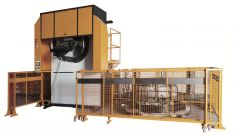 YY-2125 FULLY AUTOMATIC CNC WIRE BENDING MACHINE FOR MATTRESS SPRING UNIT, PRODUCTION CAPACITY 1400 FRAMES PER 8 HOURSYY-2125 FULLY AUTOMATIC CNC WIRE BENDING MACHINE FOR MATTRESS SPRING UNIT, PRODUCTION CAPACITY 1400 FRAMES PER 8 HOURS TECHNICAL PARAMETERS: WIRE DIAMETER: Φ3.9 – 4.1mm Φ4.2 – 4.4mm Φ4.5 – 4.7mm Φ4.8 – 5.0mm INNER DIAMETER OF WIRE ROLL: MINIMUM 1600mm OUTER DIAMETER OF WIRE ROLL: MAXIMUM 2400mm ACCEPTABLE WEIGHT OF WIRE ROLL: MAXIMUM 2500KG POWER SUPPLY: 3AC 380V 50/60 Hz OR 220V 50/60Hz INPUT CURRENT: 20A CABLE SECTION: 5 X 4MM2 AIR CONSUMPTION: 0.6M’/MIN AIR PRESSURE: 0.6 TO 0.7MPA WORKING TEMPERATURE: +5C- +45 °C POWER: 8KW PRODUCTION CAPACITY: 1400 FRAMES / 8 HOURS WEIGHT: 4000KG STANDARD: L: 1800-2200mm, W: 900-2000mm QUANTITY: 1 Learn More
YY-2125 FULLY AUTOMATIC CNC WIRE BENDING MACHINE FOR MATTRESS SPRING UNIT, PRODUCTION CAPACITY 1400 FRAMES PER 8 HOURSYY-2125 FULLY AUTOMATIC CNC WIRE BENDING MACHINE FOR MATTRESS SPRING UNIT, PRODUCTION CAPACITY 1400 FRAMES PER 8 HOURS TECHNICAL PARAMETERS: WIRE DIAMETER: Φ3.9 – 4.1mm Φ4.2 – 4.4mm Φ4.5 – 4.7mm Φ4.8 – 5.0mm INNER DIAMETER OF WIRE ROLL: MINIMUM 1600mm OUTER DIAMETER OF WIRE ROLL: MAXIMUM 2400mm ACCEPTABLE WEIGHT OF WIRE ROLL: MAXIMUM 2500KG POWER SUPPLY: 3AC 380V 50/60 Hz OR 220V 50/60Hz INPUT CURRENT: 20A CABLE SECTION: 5 X 4MM2 AIR CONSUMPTION: 0.6M’/MIN AIR PRESSURE: 0.6 TO 0.7MPA WORKING TEMPERATURE: +5C- +45 °C POWER: 8KW PRODUCTION CAPACITY: 1400 FRAMES / 8 HOURS WEIGHT: 4000KG STANDARD: L: 1800-2200mm, W: 900-2000mm QUANTITY: 1 Learn More -
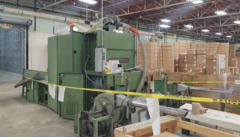 YY-2099 AMERICAN TRUETZSCHLER INC FIBER FILLING MACHINEYY-2099 AMERICAN TRUETZSCHLER INC FIBER FILLING MACHINE QUANTITY: 3 Learn More
YY-2099 AMERICAN TRUETZSCHLER INC FIBER FILLING MACHINEYY-2099 AMERICAN TRUETZSCHLER INC FIBER FILLING MACHINE QUANTITY: 3 Learn More -
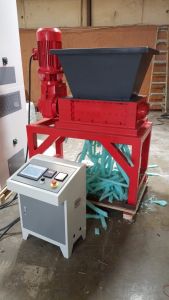 J-3650 DOUBLE SHAFT SHREDDER, 400 KGS PER HOUR, ROLL WORKING WIDTH 600mmJ-3650 DOUBLE SHAFT SHREDDER, 400 KGS PER HOUR, ROLL WORKING WIDTH 600mm KNIVES: 30, DIAMETER 200mm x 0mm (OD x T) SPACERS: 30, DIAMETER 120mm x 20mm (OD x T) SHAFTS: 2, DIAMETER 90mm x 1100mm (OD x T) CHAMBER DIMENSIONS: 600mm LENGTH x 360mm WIDTH MOTOR POWER: 7.5 KW QUANTITY: 1 Learn More
J-3650 DOUBLE SHAFT SHREDDER, 400 KGS PER HOUR, ROLL WORKING WIDTH 600mmJ-3650 DOUBLE SHAFT SHREDDER, 400 KGS PER HOUR, ROLL WORKING WIDTH 600mm KNIVES: 30, DIAMETER 200mm x 0mm (OD x T) SPACERS: 30, DIAMETER 120mm x 20mm (OD x T) SHAFTS: 2, DIAMETER 90mm x 1100mm (OD x T) CHAMBER DIMENSIONS: 600mm LENGTH x 360mm WIDTH MOTOR POWER: 7.5 KW QUANTITY: 1 Learn More -
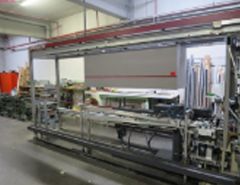 ZELLWEGER USTER DELTA 200 DRAWING MACHINE, YEAR 1992REFERENCE NUMBER: T-6974 ZELLWEGER USTER DELTA 200 DRAWING MACHINE, YEAR 1992 MANUFACTURER: ZELLWEGER USTER TYPE: DELTA 200 YEAR: 1992 WORKING WIDTH: 2 X 2000mm OR 3900mm (DOUBLE WIDTH) 3 WARP BEAMING FRAMES TYPE USTERDELTA WITH EXTRA TREE INSTALLATION CREEL APPROX. 200,000 DROPPERS & HEDDLES EXTRA BEAMING CREEL AND ACCESSORIES QUANTITY: 1 Learn More
ZELLWEGER USTER DELTA 200 DRAWING MACHINE, YEAR 1992REFERENCE NUMBER: T-6974 ZELLWEGER USTER DELTA 200 DRAWING MACHINE, YEAR 1992 MANUFACTURER: ZELLWEGER USTER TYPE: DELTA 200 YEAR: 1992 WORKING WIDTH: 2 X 2000mm OR 3900mm (DOUBLE WIDTH) 3 WARP BEAMING FRAMES TYPE USTERDELTA WITH EXTRA TREE INSTALLATION CREEL APPROX. 200,000 DROPPERS & HEDDLES EXTRA BEAMING CREEL AND ACCESSORIES QUANTITY: 1 Learn More -
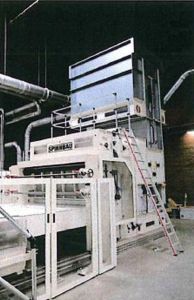 SPINNBAU CARDING LINE, YEAR 2013REFERENCE NUMBER: T-6848 SPINNBAU CARDING LINE, YEAR 2013 BRAND: SPINNBAU SHORT DESCRIPTION: CARDING LINE YEAR: 2013 INSTALLED 2014 LIKE NEW, LITTLE RUN TIME 4 HOPPER TEMAFA BLEND LINE, 1600mm WIDE, 1 WITH CONDENSER FED FROM TRIM MACHINE CARDING WILLOW – 800mm WIDE FEED BELT AND 1200mm WIDE – TEMAFA TEMAFA MIXMASTER BLENDING BIN – 3000mm WIDE X 8000mm LONG X 4600mm HIGH (FILL HEIGHT 3000mm). 72 CUBIC METER CAPACITY. TEMAFA FINE OPENER – 2000mm WIDE WITH PINS 3000mm SPINNBAU CARD FEEDING UNIT – FEED TRUNK, VIBRATING CHUTE, WEIGHT BELT 708mm BREAST SECTION WITH 3 WORKERS AND STRIPPERS, 1500mm MAIN WITH 5 W/S AND (2) 708mm DOFFERS. 1 FOUNDATIONS AND PLATFORMS. DILO PROFILINE – BATT WEIGHT CONTROL SYSTEM MAHLO WEIGHT MEASURING UNIT – QUALISCAN CMS-12 DILO LAYER CROSSLAPPER – TYPE DLS 30/60 – 3000mm INFEED AND UP TO 6000mm LAYDOWN. MAX WEB HEIGHT 650mm. MAXIMUM SPEED 125M/MIN. SPINNBAU LAP DRAFTER TYPE VST 19 – MAX 6000mm WORKING WIDTH. 9 ROLLER PAIRS. LIFTING DEVICE TO ALLOW FOR 600mm CLEARANCE. 159mm ROLLER DIAMETER. INFEED HEIGHT 650 mm BRUCKNER THERMOBONDING OVEN – 5000mm OVEN WITH 3 HEATING AND 2 COOLING ZONE. MAGNETIC BELT. 3 NATURAL GAS MAXON BURNER. SLITTING – 9 POSITION BRUCKNER CRUSH CUTTER SLITTING HEADS. PNEUMATIC LIFTING. 450mm KNIFE DIAMETER CROSS CUTTER – ROTARY CUTTER STYLE WITH CLAMPING. CAPABLE OF 3 CUTS/MINUTES FOR MATERIALS UP TO 200mm THICK. WINDING – ASCENDING BATCH STYLE WINDER. MAX ROLL DIAMETER OF 1200mm. 3000mm DRIVEN FEED CONVEYOR. MANDREL GUIDANCE SYSTEM, MANUALLY ADJUSTABLE BRAKE SYSTEM FOR CONTROLLING TENSILE FORCE AND COMPACTION. TEMAFA FILTER HOUSE – TFS 50. MAX FLOW 50,000 CUBIC METER/H ELECTRICL INFO – 3 X 480V/60Hz. CONTROLS 110V AC/24 DC. SIEMENS PLC QUANTITY: 1 Learn More
SPINNBAU CARDING LINE, YEAR 2013REFERENCE NUMBER: T-6848 SPINNBAU CARDING LINE, YEAR 2013 BRAND: SPINNBAU SHORT DESCRIPTION: CARDING LINE YEAR: 2013 INSTALLED 2014 LIKE NEW, LITTLE RUN TIME 4 HOPPER TEMAFA BLEND LINE, 1600mm WIDE, 1 WITH CONDENSER FED FROM TRIM MACHINE CARDING WILLOW – 800mm WIDE FEED BELT AND 1200mm WIDE – TEMAFA TEMAFA MIXMASTER BLENDING BIN – 3000mm WIDE X 8000mm LONG X 4600mm HIGH (FILL HEIGHT 3000mm). 72 CUBIC METER CAPACITY. TEMAFA FINE OPENER – 2000mm WIDE WITH PINS 3000mm SPINNBAU CARD FEEDING UNIT – FEED TRUNK, VIBRATING CHUTE, WEIGHT BELT 708mm BREAST SECTION WITH 3 WORKERS AND STRIPPERS, 1500mm MAIN WITH 5 W/S AND (2) 708mm DOFFERS. 1 FOUNDATIONS AND PLATFORMS. DILO PROFILINE – BATT WEIGHT CONTROL SYSTEM MAHLO WEIGHT MEASURING UNIT – QUALISCAN CMS-12 DILO LAYER CROSSLAPPER – TYPE DLS 30/60 – 3000mm INFEED AND UP TO 6000mm LAYDOWN. MAX WEB HEIGHT 650mm. MAXIMUM SPEED 125M/MIN. SPINNBAU LAP DRAFTER TYPE VST 19 – MAX 6000mm WORKING WIDTH. 9 ROLLER PAIRS. LIFTING DEVICE TO ALLOW FOR 600mm CLEARANCE. 159mm ROLLER DIAMETER. INFEED HEIGHT 650 mm BRUCKNER THERMOBONDING OVEN – 5000mm OVEN WITH 3 HEATING AND 2 COOLING ZONE. MAGNETIC BELT. 3 NATURAL GAS MAXON BURNER. SLITTING – 9 POSITION BRUCKNER CRUSH CUTTER SLITTING HEADS. PNEUMATIC LIFTING. 450mm KNIFE DIAMETER CROSS CUTTER – ROTARY CUTTER STYLE WITH CLAMPING. CAPABLE OF 3 CUTS/MINUTES FOR MATERIALS UP TO 200mm THICK. WINDING – ASCENDING BATCH STYLE WINDER. MAX ROLL DIAMETER OF 1200mm. 3000mm DRIVEN FEED CONVEYOR. MANDREL GUIDANCE SYSTEM, MANUALLY ADJUSTABLE BRAKE SYSTEM FOR CONTROLLING TENSILE FORCE AND COMPACTION. TEMAFA FILTER HOUSE – TFS 50. MAX FLOW 50,000 CUBIC METER/H ELECTRICL INFO – 3 X 480V/60Hz. CONTROLS 110V AC/24 DC. SIEMENS PLC QUANTITY: 1 Learn More -
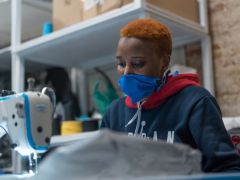 D-2388 What’s the Best Material for a Mask?
D-2388 What’s the Best Material for a Mask?Federal health officials have now recommended that we cover our faces with fabric during the coronavirus pandemic. But what material offers the most protection?
The Centers for Disease Control and Prevention has posted a no-sew mask pattern using a bandanna and a coffee filter as well as a video on making masks using rubber bands and folded fabrics found at home.
While a simple face covering can reduce the spread of coronavirus by blocking outgoing germs from coughs or sneezes of an infected person, experts say there is more variation in how much homemade masks might protect the wearer from incoming germs, depending on the fit and quality of the material used.
Scientists around the country have taken it upon themselves to identify everyday materials that do a better job of filtering microscopic particles. In recent tests, HEPA furnace filters scored well, as did vacuum cleaner bags, layers of 600-count pillowcases and fabric similar to flannel pajamas. Stacked coffee filters had medium scores. Scarves and bandanna material had the lowest scores, but still captured a small percentage of particles.
If you don’t have any of the materials that were tested, a simple light test can help you decide whether a fabric is a good candidate for a mask.
“Hold it up to a bright light,” said Dr. Scott Segal, chairman of anesthesiology at Wake Forest Baptist Health who recently studied homemade masks. “If light passes really easily through the fibers and you can almost see the fibers, it’s not a good fabric. If it’s a denser weave of thicker material and light doesn’t pass through it as much, that’s the material you want to use.”
Researchers say it’s important to remember that lab studies are conducted under perfect conditions with no leaks or gaps in the mask, but the test methods give us a way to compare materials. And while the degree of filtration for some homemade masks seems low, most of us — who are staying home and practicing social distancing in public — don’t need the high level of protection required for medical workers. More important, any face covering is better than none, especially if worn by a person who has the virus but doesn’t know it.
The biggest challenge of choosing a homemade mask material is to find a fabric that is dense enough to capture viral particles, but breathable enough that we can actually wear it. Some items being touted online promise high filtration scores, but the material would be unwearable.
Dressing Up for Work … at Home
Yang Wang, an assistant professor of environmental engineering at Missouri University of Science and Technology, worked with his graduate students to study various combinations of layered materials — including both air filters and fabric. “You need something that is efficient for removing particles, but you also need to breathe,” said Dr. Wang, who last fall won an international award for aerosol research.To test everyday materials, scientists are using methods similar to those used to test medical masks, which everybody agrees should be saved for medical workers who are exposed to high doses of virus from seeing infected patients. The best medical mask — called the N95 respirator — filters out at least 95 percent of particles as small as 0.3 microns. By comparison, a typical surgical mask — made using a rectangular piece of pleated fabric with elastic ear loops — has a filtration efficiency ranging from 60 to 80 percent.
Dr. Wang’s group tested two types of air filters. An allergy-reduction HVAC filter worked the best, capturing 89 percent of particles with one layer and 94 percent with two layers. A furnace filter captured 75 percent with two layers, but required six layers to achieve 95 percent. To find a filter similar to those tested, look for a minimum efficiency reporting value (MERV) rating of 12 or higher or a microparticle performance rating of 1900 or higher.
The problem with air filters is that they potentially could shed small fibers that would be risky to inhale. So if you want to use a filter, you need to sandwich the filter between two layers of cotton fabric. Dr. Wang said one of his grad students made his own mask by following the instructions in the C.D.C. video, but adding several layers of filter material inside a bandanna.
Dr. Wang’s group also found that when certain common fabrics were used, two layers offered far less protection than four layers. A 600 thread count pillow case captured just 22 percent of particles when doubled, but four layers captured nearly 60 percent. A thick woolen yarn scarf filtered 21 percent of particles in two layers, and 48.8 percent in four layers. A 100 percent cotton bandanna did the worst, capturing only 18.2 percent when doubled, and just 19.5 percent in four layers.
The group also tested Brew Rite and Natural Brew basket-style coffee filters, which, when stacked in three layers, showed 40 to 50 percent filtration efficiency — but they were less breathable than other options.
If you are lucky enough to know a quilter, ask them to make you a mask. Tests performed at the Wake Forest Institute for Regenerative Medicine in Winston-Salem, N.C., showed good results for homemade masks using quilting fabric. Dr. Segal, of Wake Forest Baptist Health, who led the study, noted that quilters tend to use high-quality, high-thread count cotton. The best homemade masks in his study were as good as surgical masks or slightly better, testing in the range of 70 to 79 percent filtration. Homemade masks that used flimsier fabric tested as low as 1 percent filtration, Dr. Segal said.
The best-performing designs were a mask constructed of two layers of high-quality, heavyweight “quilter’s cotton,” a two-layer mask made with thick batik fabric, and a double-layer mask with an inner layer of flannel and outer layer of cotton.
Bonnie Browning, executive show director for the American Quilter’s Society, said that quilters prefer tightly woven cottons and batik fabrics that stand up over time. Ms. Browning said most sewing machines can handle only two layers of fabric when making a pleated mask, but someone who wanted four layers of protection could wear two masks at a time.
Ms. Browning said she recently reached out to quilters on Facebook and heard from 71 people who have made a combined total of nearly 15,000 masks. “We quilters are very much in the thick of what’s going on with this,” said Ms. Browning, who lives in Paducah, Ky. “One thing most of us have is a stash of fabric.”
People who don’t sew could try a folded origami mask, created by Jiangmei Wu, assistant professor of interior design at Indiana University. Ms. Wu, who is known for her breathtaking folded artwork, said she began designing a folded mask out of a medical and building material called Tyvek, as well as vacuum bags, after her brother in Hong Kong, where mask wearing is common, suggested it. (DuPont, the maker of Tyvek, said in a statement that Tyvek is intended for medical apparel, not masks.) The folded mask pattern is free online, as is a video demonstrating the folding process. In tests at Missouri University and University of Virginia, scientists found that vacuum bags removed between 60 percent and 87 percent of particles. But some brands of vacuum bags may contain fiberglass or are harder to breathe through than other materials, and shouldn’t be used. Ms. Wu used a bag by EnviroCare Technologies, which has said it does not use fiberglass in its paper and synthetic cloth bags.
“I wanted to create an alternative for people who don’t sew,” said Ms. Wu, who said she is talking to various groups to find other materials that will be effective in a folded mask. “Given the shortage of all kinds of materials, even vacuum bags might run out.”
The scientists who conducted the tests used a standard of 0.3 microns because that is the measure used by the National Institute for Occupational Safety and Health for medical masks.
Linsey Marr, a Virginia Tech aerosol scientist and an expert in the transmission of viruses, said the certification method for respirators and HEPA filters focuses on 0.3 microns because particles around that size are the hardest to catch. While it seems counterintuitive, particles smaller than 0.1 microns are actually easier to catch because they have a lot of random motion that makes them bump into the filter fibers, she said.
“Even though coronavirus is around 0.1 microns, it floats around in a wide range of sizes, from around 0.2 to several hundred microns, because people shed the virus in respiratory fluid droplets that also contain lots of salts and proteins and other things,” said Dr. Marr. “Even if the water in the droplets fully evaporates, there’s still a lot of salt and proteins and other gunk that stays behind as solid or gel-like material. I think 0.3 microns is still useful for guidance because the minimum filtration efficiency will be somewhere around this size, and it’s what NIOSH uses.”
Learn More -
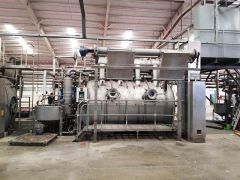 J-2640 DYEING AND FINISHING PLANT FOR SALE
J-2640 DYEING AND FINISHING PLANT FOR SALEREFERENCE NUMBER: J-2640
DYEING AND FINISHING PLANT FOR SALEITEM 001
THIES SAMPLE DYEING MACHINE
MODEL: MINISOFT SAMPLE
CAPACITY: 50 KGS
YEAR: 1999
MICROPROCESSOR CONTROLLED
VOLTAGE: 460 VOLTS, 3-PHASE, 60 Hz
SINGLE ADD TANK WITH MIXER
HEAT EXCHANGER
ALL PUMPS AND MOTORS
LOADING REEL AND FABRIC EXIT PLAITOR
QUANTITY: 1ITEM 002
THIES DYEING MACHINE
MODEL ECOSOFT PLUS
3 PORT SPLIT/SPLIT
CAPACITY: 900 KGS
YEAR: 1999
MICROPROCESSOR CONTROLLED
VOLTAGE: 460 VOLTS, 3-PHASE, 60 Hz
SINGLE ADD TANK WITH MIXER
HEAT EXCHANGER
ALL PUMPS AND MOTORS
LOADING REEL AND FABRIC EXIT PLAITOR
QUANTITY: 1ITEM 003
THIES DYEING MACHINE
MODEL: ECOSOFT PLUS
2 PORT SPLIT/SPLIT
CAPACITY: 600 KGS
YEAR: 1999
MICROPROCESSOR CONTROL
VOLTAGE: 460 VOLTS, 3-PHASE, 60 Hz
SINGLE ADD TANK WITH MIXER
HEAT EXCHANGER
ALL PUMPS AND MOTORS
LOADING REEL AND FABRIC EXIT PLAITOR
QUANTITY: 1ITEM 004
THIES DYEING MACHINE
MODEL ECOSOFT PLUS
1 PORT SPLIT/SPLIT
CAPACITY: 300 KGS
YEAR: 1999
MICROPROCESSOR CONTROLLED
VOLTAGE: A460 VOLTS, 3-PHASE, 60 Hz
SINGLE ADD TANK WITH MIXER
HEAT EXCHANGER
ALL PUMPS AND MOTORS
LOADING REEL AND FABRIC EXIT PLAITOR
QUANTITY: 1ITEM 005
GASTON COUNTY DYEING MACHINE
MODEL: AQUAFLOW
2 PORT
CAPACITY; 250 KGS
YEAR: 1987
MICROPROCESSOR CONTROLLED
VOLTAGE: 460 VOLTS, 3-PHASE, 60 Hz
SINGLE ADD TANK WITH MIXER
HEAT EXCHANGER
ALL PUMPS AND MOTORS
LOADING AND UNLOADING REEL
QUANTITY: 1ITEM 006
THIES DYEING MACHINE
MODEL: SOFT TRD
2 TUBE
CAPACITY: 700 KGS
YEAR: 1999
MICROPROCESSOR CONTROLLED
VOLTAGE: 460 VOLTS, 3-PHASE, 60 Hz
SINGLE ADD TANK WITH MIXER
HEAT EXCHANGER
ALL PUMPS AND MOTORS
LOADING REEL AND FABRIC EXIT PLAITOR
QUANTITY: 1ITEM 007 (also our J-2647)
LAFER OPEN WIDTH COMPACTOR MACHINE
MODEL: KSA 500 2400/2200
YEAR: 1998
LAFER TEXEN CONTROLS
VOLTAGE: 480 VOLTS, 3-PHASE, 60 Hz
COMPOSED OF:
• TENSION BAR ENTRY TO LATTICE ROLL GUIDER
• OPERATOR’S PLATFORM
• PUP TENTER WITH KNIT ENTRY, VERTICAL PIN CHAIN, WITH PLATE GUIDES, RAIL OPENING, PINNING BRUSHES, PINS ONLY, WITH SUPPORT SECTION FOR THE FABRIC IN THE CENTER, AT 10’ THERE IS A STEAMING SECTION, TOTAL LENGTH OF THE TENTER IS 30’, WITH AUTOMATIC LUBRICATION FOR THE CHAIN
• KSA 500 COMPACTOR BENCH WITH TEXEN CONTROLS
• TENSIONLESS FABRIC CONVEYOR
• PLAITOR AND FABRIC SCRAY WITH OPTICAL LOAD SENSOR
• INLINE INSPECTION BATCHER MACHINE, WITHH A BACK LIGHTED BOARD, MANUAL CUT
• SCALE TO WEIGHT THE FABRIC
QUANTITY: 1ITEM 008 (also our J-2648)
SANTEX TUBULAR 4-ROLL EXTRACTION PAD
MODEL: SANTASTRETCH PLUS 140
YEAR: 1998
COMPOSED OF TURNTABLE, DETWISTER, TUBULAR 4-ROLL PAD WITH WET SPREADERS, PLAITOR
WITH ADDITION TANKS FOR SOFTENER
REEL FABRIC PLAITOR EXIT
VOLTAGE: 460 VOLTS, 3-PHASE, 60 Hz
QUANTITY: 1ITEM 009
SANTEX CONVEYOR DRYER FOR OPEN WIDTH AND TUBULAR FABRIC
MODEL: SANTASHRINK 4/5240
YEAR: 1998
SANTEX CONTROLS
VOLTAGE: 460 VOLTS, 3-PHASE, 60 Hz
COMPOSED OF:
• TENSION BAR ENTRY TO LATTICE ROLL GUIDER TO
• (2) SANTEX 2-ROLL PADS, RUBBER OVER RUBBER, 102” WIDE x 12” DIAMETER, STAINLESS STEEL PAN, 10-TON PAD, SWING-AWAY PAN, TENSION BAR WITH 2 STAINLESS STEEL MIXING TANKS, 75 GALLONS EACH
• DRIVEN SCROLL ROLLS WITH EDGE GUIDE CONTROL, WIDTH 95”
• OPERATOR’S PLATFORM
• PUP TENTER WITH KNIT ENTRY 45°, YEAR 1998, VERTICAL PIN CHAIN, 30’ LONG WITH TANDEMATIC PLATE GUIDES, RAIL GUIDES, PINNING BRUSHES, GUIDE SUPPORT FOR THE FABRIC, FABRIC CONVEYOR TO ENTER BOTH TUBULAR OR OPEN WIDTH FABRIC TO
• CONVEYOR DRYER 100” WIDE, 5 ZONES, 3-PASS WITH MAXON BURNERS, 5 CIRCULATING FANS TO CONVEYOR BELT TO PLAITOR
• ALL MOTORS AND SANTEX CONTROLS AND MONITORS
QUANTITY: 1ITEM 010
SANTEX AG TUBULAR COMPACTOR MACHINE
MODEL: SANTASPREAD 140
YEAR: 1998
SANTEX CONTROLS
VOLTAGE: 460 VOLTS, 3-PHASE, 60 Hz
COMPOSED OF:
• TENSIONS BAR ENTRY
• OPERATOR’S PLATFORM
• TENSION DEVICE
• DRIVEN SPREADER BARS
• STEAMING DEVICE
• TUBULAR COMPACTING BENCH
• FELT BLANKET ONTO THE CONVEYOR BELT
• PRECISION PLAITOR
• TABELTOP ELECTRONIC SCALE
QUANTITY: 1ITEM 011
COMET NAPPER
MODEL: PEGSO-X4
YEAR: 1998
VOLTAGE: 480 VOLTS, 3-PHASE, 60 Hz
24 ROLLS WITH TURNING BARS FOR TUBULAR 90” WIDE
XYCOM CONTROLS
12-BAG COLLECTION SYSTEM AND PLAITOR
YEAR: 1996
QUANTITY: 1ITEM 012
STENTEX TENTER FRAME
MODEL: STENTOTHERM 3300
YEAR: 1999
STENTEX CONTROLS
VOLTAGE: 480 VOLTS, 3-PHASE, 60 Hz
COMPOSED OF:
• TENSION ENTRY TO TEXT-STAR TYPE GUIDER TO 2 ROLL PAD
• ADDITION TANK TOP SCRAY PAD TO TEXT-STAR TYPE GUIDER
• TWO ROLL PAD R/R 10 TON
• OPERATOR’S PLATFORM
• WORKING WIDTH 1800mm
• HORIZONTAL PIN CHAIN, KNIT ENTRY
• TANDEMATIC SPLITLEVEL DECURLERS
• OVERFEED
• PINNING BRUSHES
• STEAM BOX
• RAIL GUIDERS, 20 FEET ENTRY, 8 ZONES
• 80 FEET HOUSING
• SCREEN MONITORS
• GAS FIRED, MAXON OVEPAK 408 BURNERS
• HONEYWELL CONTROLS
• 3 FEET COOLING ZONE
• 2 COOLING CANS, SELVEDGE TRIMMERS
• PLIATOR, SCRAY
• ZONE IN LINE INSPECTION BATCHER
QUANTITY: 1ITEM 013
ZIMMER ROTARY SCREEN PRINTING MACHINE
MODEL: R92-S153
YEAR: 1993
COMPOSED OF:
• TENSION BAR SKY ENTRY
• SCRAY
• CORINO BRUSH
• CORINO PRINT GUIDER
• ZIMMER PRINTER, 8 COLOR, 86” BLANEKT
• PRINT CONVEYOR DRYER, 30’ LONG, 3-ZONE, GAS FIRED
VOLTAGE: 460 VOLTS, 3-PHASE, 60 Hz
QUANTITY: 1ITEM 014
Learn More
SAFETY SWITCH BULLET NOSE SLITTER
MODEL: CUTTING
WITH REEL FABRIC PLIATOR
VOLTAGE: 460 VOLTS, 3-PHASE, 60 Hz
QUANTITY: 1 -
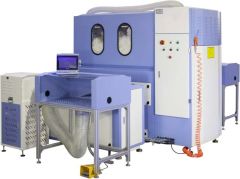 L-5578 DOUBLE PORT FILLING MACHINE, MODEL P-8G
L-5578 DOUBLE PORT FILLING MACHINE, MODEL P-8GREFERENCE NUMBER: L-5578
DOUBLE PORT FILLING MACHINE, MODEL P-8G
MODEL P-8G
VOLTAGE 220V 50/60HZ
AIR DELIVERY SPEED 0.8M³/MIN
POWER 1.7KW
FILLING MATERIALS DOWN 70%-90%
QUANTITY: 1
Learn More -
 L-5577 DOUBLE PORT FILLING MACHINE, MODEL P-6G
L-5577 DOUBLE PORT FILLING MACHINE, MODEL P-6GREFERENCE NUMBER: L-5577
DOUBLE PORT FILLING MACHINE, MODEL P-6G
MODEL P-6G
VOLTAGE 220V 50/60HZ
AIR DELIVERY SPEED 0.8M³/MIN
POWER 1.7KW
FILLING MATERIALS DOWN 70%-90%
QUANTITY: 1
Learn More -
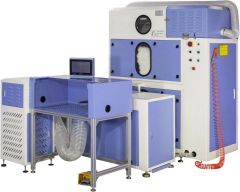 L-5576 SINGLE PORT FILLING MACHINE, MODEL P-3G
L-5576 SINGLE PORT FILLING MACHINE, MODEL P-3GREFERENCE NUMBER: L-5576
SINGLE PORT FILLING MACHINE, MODEL P-3G
VOLTAGE 220V 50/60HZ
AIR DELIVERY SPEED 0.5M³/MIN
POWER 1.7KW
FILLING MATERIALS DOWN 70%-90%
QUANTITY: 2
Learn More
